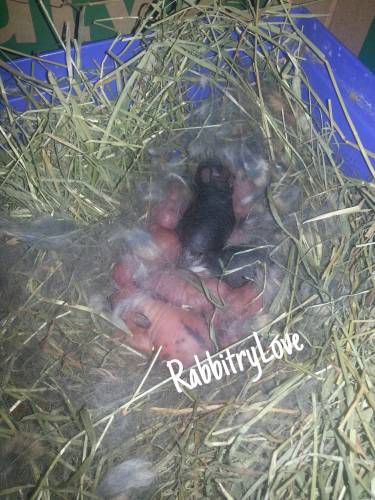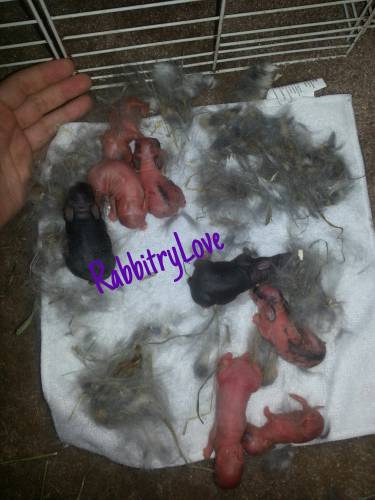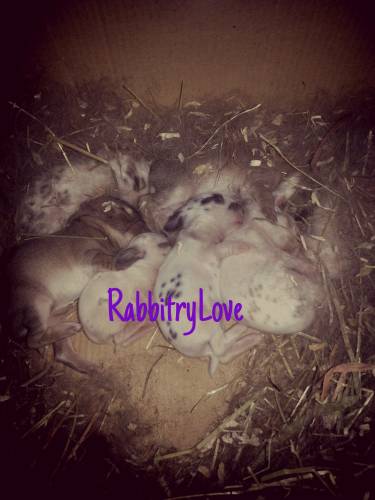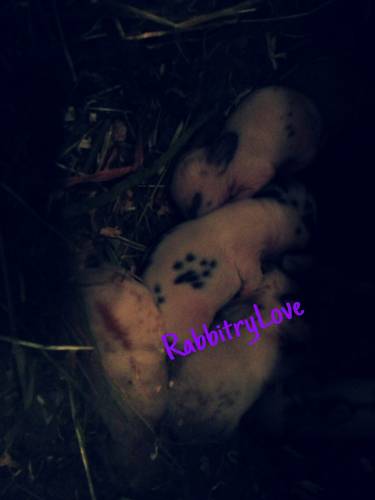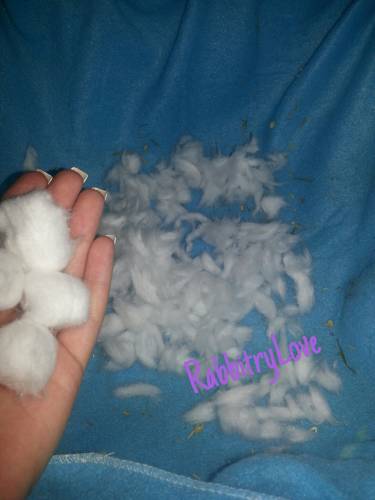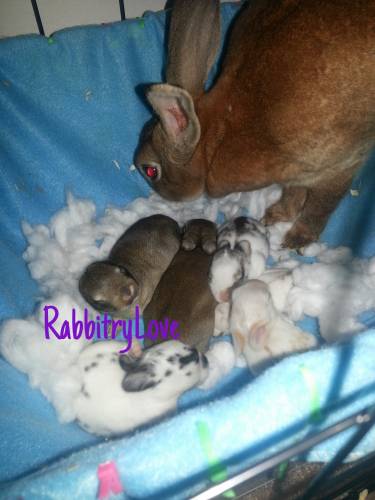The Pregnant Doe
Once the doe is pregnant, whether is was accidental or not, you will have to make preparations to ensure that she has a safe and healthy pregnancy as well as healthy offspring.
- Your doe will give birth from 32-35 days after she mated.
- Your doe MUST have her OWN living quarters while pregnant and after giving birth. (Bucks can hurt them if not separated)
- Be sure to feed your doe plenty and make sure she has water daily. She may drink more water than usual.
- At about 14 days from the day she mated, You can gently palpate her stomach to check for marble like balls in her stomach. Doing so should only be by someone who knows how to do it properly.
- Your doe may show some behavioral changes. Don't feel bad if she is more aggressive towards you.
- Try not to pick her up after her second half of her pregnancy. Doing so could harm the babies.
- At around 27 days, clean your does cage.
- At 28 days, Place a Nest box into her cage. She will use this to give birth in. It has to have a floor so you will be able to remove the box to clean her cage and to check on the kits. Place some hay in her cage, she may use it to make a nest.
- Either a few days before or even a few hours before she is ready to give birth, She will start to pull fur from her chest and sides to line the nest. Do not be alarmed. This is so that her kits stay warm. She should give birth soon after.
- It is important that you do NOT disturb her or make noise while she is giving birth or after. If she is inside the nest box with her young, do not take her out, she may be still giving birth or feeding her babies and having that extra attention may cause her to not finish feeding them.
Here is a Nest box. You can also make a homemade box.
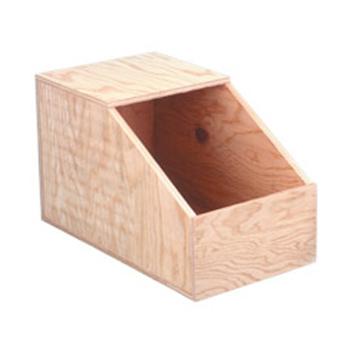
Birth
Rabbits give birth quickly and silently and usually at night time. A few hours after the doe gives birth, you will need to lift her out of her cage and check on the kits. Do not be alarmed if there are dead kits or even dis-formed kits as we refer to them as "peanuts". Dead kits and 'peanuts' are common for a does first litter. Remove any that are dead or any peanuts. The doe usually eats all afterbirth. They do this so that their nest does not attract predators. If there are any left over afterbirth, remove it as well. When done, replace the doe in her cage. Do not reach inside the nest while the doe is in the cage, doing so can cause an unintentional bite from her, growl or thump of warning.
If you notice a kit outside of the box , replace it with the rest of the kits inside the nest. Rabbits will not place their young inside the nest and if you don't do it for them, the kit will get cold and die. Replace the soft fur back on top of them when you are finished.
Here is a nest. Only hours old.
One day old Kits. These kits were removed from the cage to be checked. You do not have to remove them completely. These were removed to be placed inside a nest box along with the original nest build outside the box along with the fur.
Newborn Rabbits
Rabbits are born with their eyes and ears closed and they are hairless. The doe will nurse them usually at night time, once maybe twice a day. Do not be alarmed if you do not see her nurse them. They usually do not like to do it while being watched. You can check the kits during the morning and see if their belly's appear round. If you see that one or two may not be nursing well, You can feed the kit cats formula ONCE a day with a dropper. Do NOT force the kit to eat. A bottle is not recommended. At about 3 weeks, you will notice that the litter will start to move around and may start nibbling on straw, hay and foods. When the pups are about seven weeks and are eating and drinking properly, they will be ready for their new homes.
Additional pictures of my Abby's first litter.
One week old kits:
COMMON QUESTIONS:
Q: The nest became extremely soiled or moist. I cleaned it out but hardly have any fur left. What can I use in place of the fur?
A: Cotton balls! Just get a few cotton balls (make sure they are from a new pack with nothing on them) Pull them apart and place inside the nest box.
Q: Some of the kits look like they aren't getting enough milk or any at all, what do I do?
A: Unless the mother rabbit is known to be dead, there is a good chance that she is feeding her babies, even if she seems to be ignoring them. The mother does not stick around their babies constantly. This is because they don't want to attract predators. They usually only feed their babies once or twice a day and more likely at night or when they aren't being watched. Check the kits tummies to see if they are round and full looking.If the babies are very wrinkled, cold, bluish in color and have shrunken bellies then you may intervene.
If you still believe that the kit is not getting any milk. You can buy kitten milk replacer and a syringe or dropper. Do not force the kit to eat. Let him drink it himself. Newborn to One Week: two - two and a half cc/ml each feeding (two feedings per day). One to two weeks: 5-7 cc/ml each feeding (two feedings per day). The amount will depending on rabbit and may be less if the rabbit it much smaller. Two to three weeks: 7-13 cc/ml each feeding (two feedings). Start introducing them to hay at this time. If the kit seems to be eating a little bit from the mother then only feed ONCE a day with the KMR.
